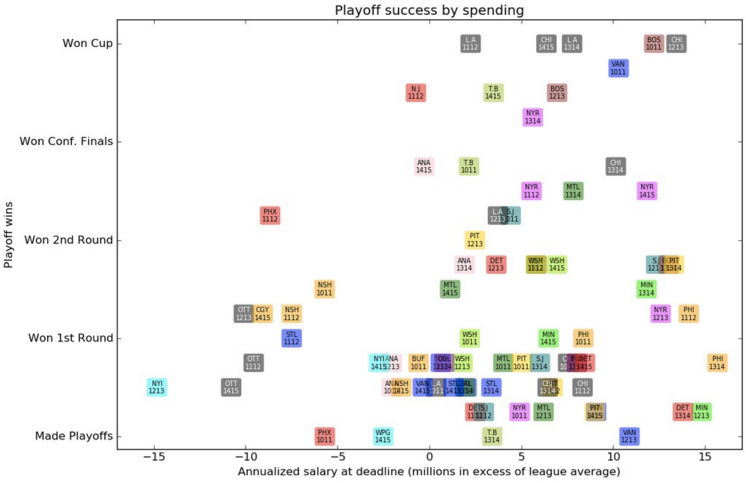One buzzword Gary Bettman and the NHL have trumpeted for years is ‘parity.’ Since the 2004-05 lockout that wiped out an entire season and fundamentally changed the financial landscape, it’s been a theme for the league.
The league’s desire to market this competitive balance makes sense. It makes it appear as though any team could turn its fortunes around on a dime with each new season and provide real optimism for any fan base. Selling that ideology promotes inclusion and keeps people who may have otherwise tuned out coming back for more.
But when you dig a little deeper, the parity isn’t so clear. While the hard cap system has certainly made it more difficult for teams to simply keep rolling over the same personnel groups, the avant-garde organizations have eventually found a way to work around its restrictive nature by flexing their financial muscles more creatively.
For example, take the Chicago Blackhawks, a team that needed to completely rearrange its entire supporting cast after winning the 2010 Stanley Cup. Despite continually bleeding talent ever since, they’ve been able to keep their well-oiled machine humming thanks to clever manipulation. Whether it’s by meticulously structuring contracts, or by using future assets to get other teams to retain salary so that they can make the numbers work, by the end of this year’s trade deadline Chicago had more than $90 million in salary on their books despite the $71.4 million cap.
They’re hardly the only team that has taken advantage of its spending power. Below is a list of teams that have qualified for the playoffs since the 2010-11 season, sorted by how much money they doled out and how many post-season games they won:
Sure enough, nearly every team that played well into the post-season in that span was on the higher end of the payroll spectrum. Meanwhile, the only two teams that won more than one playoff round while spending less than the league average in a given season were the Coyotes and Devils:
The Ducks will be an interesting case study to follow in the months ahead, because their current payroll is well below the league average despite their contender status. The thing with them is that regardless of how their post-season plays out, they’ll have some difficult decisions to make this summer. Either they’ll lift their self-imposed internal budget and become one of the highest spending teams in the league by retaining Hampus Lindholm, Sami Vatanen, Rickard Rakell (and potentially even Frederik Andersen), or they’ll look like a drastically different team next season.
Each organization needs to objectively assess what their endgame is. For some, simply staying afloat and grabbing the revenue from a couple of home playoff games is attainable by investing the bare minimum in their product. Each post-season, we see a couple of patchwork teams who don’t spend a lot squeak in.
The Senators have cornered this market under Eugene Melnyk’s watch in recent years. His infamous “cost-per-point” remarks are not only amusing to look back at, but they’re also rather telling. Because of how the Sens pinch pennies, they are wasting the prime years of their foundational centerpieces, who aren’t getting enough support.
That’s not to say throwing money around guarantees you anything in the way of icing a successful hockey team. A quick look at some of the Leafs and Flyers teams over the years is proof of that. The Vancouver Canucks have the seventh-highest payroll this season, which has bought them the 24th-best point percentage, fourth-worst goal differential, and a lottery ticket.
The most important factor in icing a competitive team is still a capable front office that spends its money judiciously and wisely allocates its resources.
Put it this way: spending money doesn’t ensure you’ll win, but not spending money essentially thwarts your chances of legitimately competing. It’s as if there’s a requisite cover charge that you need to pay to enter the VIP area of a club and that’s where it’ll ultimately be decided who gets to go home with the Stanley Cup.
The NHL enjoys its share of parity in the regular season and the inherent crapshoot nature of the playoffs opens the door for a wider range of outcomes. But you still need to spend to win. You’re fooling yourself if you don’t think the deck is heavily stacked in favour of teams that are paying for their seat at the table.
Thanks to NHL Numbers for pulling up the payroll figures and to Micah Blake McCurdy for putting it all together.










